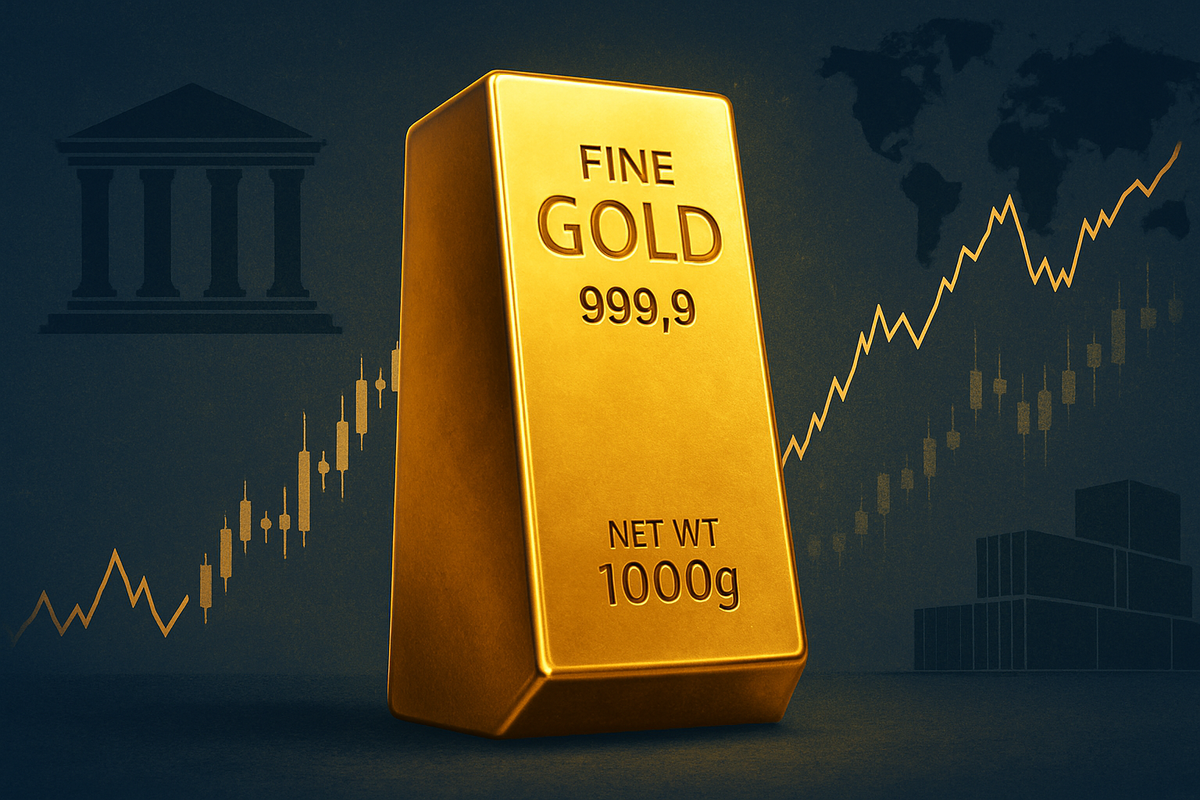
In a historic market event, safe-haven gold has surged to unprecedented levels, breaking past the $4,100 per ounce mark on October 13, 2025, and continuing its ascent to an all-time high of $4,179.48 per ounce on October 14, 2025. This monumental rally is primarily fueled by aggressive bets on imminent Federal Reserve interest rate cuts and persistent global trade jitters, painting a clear picture of investor anxiety and a widespread flight to safety.
The yellow metal's meteoric rise underscores a deepening distrust in traditional financial assets amidst a backdrop of escalating geopolitical tensions and economic uncertainties. As central banks worldwide grapple with inflation and slowing growth, gold's allure as a reliable store of value has never been stronger, signaling a significant shift in investment sentiment and potentially reshaping portfolio strategies across the financial landscape.
Unprecedented Surge: A Deep Dive into Gold's Historic Rally
The journey to gold's record-breaking valuation has been swift and decisive, culminating in a dramatic surge in mid-October 2025. On Monday, October 13, 2025, gold prices breached the psychological barrier of $4,100/oz for the first time, a move that sent ripples through global markets. The momentum continued unabated into Tuesday, October 14, 2025, with spot gold touching an astonishing $4,179.48 per ounce before settling slightly. At 07:16 GMT on October 14, spot gold was trading around $4,117.72 per ounce, later hitting an intraday record of $4,116.77.
The primary catalyst for this historic ascent is the overwhelming market expectation of aggressive interest rate cuts by the U.S. Federal Reserve. Traders are currently pricing in a near-certainty (97-99% probability) of a 25-basis-point rate cut in October 2025, with strong indications for further reductions in December. Lower interest rates diminish the appeal of yield-bearing assets, thereby reducing the opportunity cost of holding non-yielding gold and making it a more attractive investment. This dovish stance by the Fed also tends to weaken the U.S. dollar, further boosting gold's value for international buyers.
Compounding the monetary policy influence are persistent and escalating trade tensions between the United States and China. Renewed threats from President Trump regarding additional tariffs on Chinese exports and new export controls on critical software have significantly rattled investor confidence. These geopolitical headwinds, coupled with ongoing global conflicts—such as the protracted Israel-Hamas war—and domestic economic uncertainties like the recent U.S. government shutdown, have collectively propelled investors towards gold's perceived stability. Adding to this, robust central bank buying, particularly from emerging economies like China and India, has provided a strong foundational demand, as these nations diversify their reserves away from the U.S. dollar. The rally has also seen significant inflows into gold-backed Exchange Traded Funds (ETFs), indicating broad-based institutional and retail participation.
The immediate market reaction has been a pronounced flight to safe-haven assets, with silver prices also experiencing record highs, buoyed by similar market dynamics and tightness in the spot market. While the rally signals strong underlying demand, some analysts are cautioning about potential short-term corrections if the Fed's rate cuts prove less aggressive than anticipated. Nevertheless, major financial institutions like Bank of America and Société Générale are already revising their gold price forecasts upwards, with some projecting gold to reach $5,000 per ounce by 2026, and Standard Chartered raising its 2026 forecast to $4,488, underscoring the long-term bullish sentiment.
Winners and Losers: Navigating the Golden Wave
The unprecedented surge in gold prices to over $4,100 per ounce creates a distinct landscape of winners and losers across various sectors, primarily impacting companies whose fortunes are directly or indirectly tied to the precious metal.
The most immediate and significant beneficiaries are gold mining companies and gold royalty and streaming companies. For major gold miners, every additional dollar in gold price translates directly into expanded revenue and fatter profit margins, especially for those with lower "all-in sustaining costs" (AISC). Companies like Barrick Gold Corporation (NYSE: GOLD), Newmont Corporation (NYSE: NEM), and Agnico Eagle Mines Limited (NYSE: AEM) are poised to see substantial boosts to their cash flow, which can be reinvested in exploration, debt reduction, or returned to shareholders. For instance, a company like Integra Resources (TSXV: ITR), with current AISC around $2,450-$2,550/oz, stands to gain approximately $1,450/oz in operating margin at a $4,000 gold price, with even greater upside from development projects boasting projected AISC as low as $814/oz.
Even more insulated from operational risks are gold royalty and streaming companies, such as Franco-Nevada Corporation (NYSE: FNV), Wheaton Precious Metals Corp. (NYSE: WPM), and Royal Gold, Inc. (NASDAQ: RGLD). These companies provide upfront financing to miners in exchange for a percentage of future production or the right to purchase gold at a discounted price. Their business model bypasses direct mining costs, labor, and capital expenditures, leading to exceptionally high operating margins—often around 90%. As gold prices soar, their revenue streams swell without a corresponding increase in their own operational expenses, making them highly attractive investments in this environment. Franco-Nevada, for example, reported record revenue and operating cash flow in Q2 2025, with net income more than doubling, a clear testament to the leverage these models offer to rising gold prices.
Conversely, companies that rely on gold as a primary raw material face significant headwinds. Jewelry retailers and manufacturers are particularly vulnerable. Firms like Tiffany & Co. (part of LVMH) or major Indian jewelers such as Kalyan Jewellers India Ltd. (NSE: KALYANKJBR) and Titan Company Ltd. (NSE: TITAN) will experience a sharp increase in their input costs. While luxury brands might possess some pricing power to pass these costs onto affluent consumers, mass-market jewelers could see compressed profit margins, reduced demand, or be forced to innovate with lighter designs or alternative materials. Managing inventory and cash flow becomes a critical challenge as restocking becomes significantly more expensive.
Furthermore, while all gold miners generally benefit, those with particularly high operating costs or extensive hedging positions might see less relative upside. Miners struggling with elevated "all-in sustaining costs" (AISC) due to factors like higher labor, energy expenses, or lower ore grades, such as Alamos Gold (NYSE: AGI) or Harmony Gold Mining Company Limited (NYSE: HMY) which reported significant YoY AISC increases in Q1 2025, will experience thinner profit margin expansion compared to their more efficient peers. Additionally, companies that have extensively hedged their future gold production at lower prices will find their ability to capitalize on the current record-high spot prices limited, effectively capping their potential revenue gains.
Wider Significance: A Barometer of Global Instability
Gold's unprecedented ascent above $4,100 per ounce is more than just a market anomaly; it serves as a potent barometer of profound shifts in the global economic and geopolitical landscape. This rally is deeply embedded in a complex interplay of inflationary pressures, anticipated monetary policy adjustments, and escalating international tensions, signaling a broader re-evaluation of risk and value by investors worldwide.
The surge fits squarely into a broader trend of persistent inflationary concerns. Gold has historically been the quintessential hedge against the erosion of purchasing power, and current market anxieties about inflation, potentially exacerbated by protectionist trade policies, have amplified its appeal. Many market participants are now referring to the gold rally as "the great debasement trade," reflecting a growing lack of confidence in the long-term stability of fiat currencies. Simultaneously, the pervasive expectation of multiple Federal Reserve interest rate cuts in late 2025 is a critical driver. As interest rates decline, the opportunity cost of holding non-yielding assets like gold diminishes, making it more attractive. This dovish monetary outlook, coupled with a multi-month decline in the U.S. dollar's strength, further bolsters gold's appeal for international buyers and central banks seeking to diversify their reserves.
The ripple effects are diverse. For the gold mining industry, this era is a financial boom, with many companies reporting record profits and robust cash flow. While production costs have seen some increases due to factors like stricter environmental regulations and labor pressures, the soaring gold prices have led to significantly expanded profit margins. This windfall is attracting institutional investment and fostering growth initiatives, including mergers, acquisitions, and technological upgrades. Conversely, the jewelry industry faces significant challenges. Elevated gold prices translate directly into higher costs for gold jewelry, leading to a noticeable decline in consumer demand. Jewelers are adapting by promoting minimalist designs, offering lower-carat gold options (e.g., 14K becoming more prevalent), and encouraging the recycling of existing gold. While gold remains a premier safe-haven asset, some research suggests its safe-haven effect might be "fading" during extreme market volatility, with other precious metals like platinum showing a more statistically significant role in certain shocks, indicating a nuanced shift in investor perception.
On the regulatory and policy front, the sustained surge and heightened trading activity could prompt new measures. Jurisdictions might implement additional reporting requirements or trading restrictions. Furthermore, major gold markets like India and China could adjust their import/export policies, reflecting broader geopolitical realignments as gold increasingly becomes a strategic asset in international relations. The "great debasement trade" narrative also places monetary policy under intense scrutiny, challenging central banks to address concerns about inflation targets, interest rate management, and the long-term implications of their quantitative easing or tightening measures.
Historically, gold has proven its mettle during times of crisis. The 1970s stagflation saw gold prices surge by approximately 1,500% as inflation ravaged economies. The 2008 financial crisis saw gold soar by nearly 25% while equities plummeted, showcasing its resilience. More recently, the COVID-19 pandemic in 2020 saw gold climb over 27% amidst unprecedented global disruption. While the 1980 peak, adjusted for 2025 dollars, was around $3,400, the current rally's velocity and magnitude, with a 50-57% increase in a single year, make it one of the most aggressive upward movements in modern history. This "perfect storm" of economic conditions underscores a diminished confidence in traditional financial systems and a growing anxiety about global economic stability.
What Comes Next: Navigating the Golden Horizon
As gold solidifies its position above the $4,100 per ounce threshold, the market now turns its gaze to what lies ahead for the precious metal. The short-term outlook, while subject to potential volatility, remains largely bullish, underpinned by the very factors that propelled its recent surge. Long-term projections, meanwhile, paint an even more compelling picture of sustained growth, driven by fundamental shifts in the global financial architecture.
In the short term (next 6-12 months), continued upward momentum is highly anticipated. Analysts from institutions like ING forecast gold to average around $4,000/oz by late 2025 and $4,150/oz in 2026, with some projecting a push towards $4,250/oz if current bullish sentiment holds. The primary drivers will continue to be the Federal Reserve's anticipated rate cuts—with a high probability of a 25-basis-point cut in October and another in December 2025—which will further reduce the opportunity cost of holding gold. Persistent geopolitical tensions, including renewed U.S.-China trade disputes and ongoing global conflicts, alongside robust central bank buying and strong investment demand via ETFs, will provide significant tailwinds. However, the rapid appreciation also introduces the potential for a near-term correction or profit-taking. Technical indicators show gold in overbought territory, suggesting that a healthy pullback to support levels around $4,090, $4,050, or even the psychological $4,000 mark is possible.
Looking at the long term (beyond 1-2 years), the outlook for gold is exceptionally robust. Major financial institutions like Bank of America and Société Générale now project gold to reach $5,000 per ounce by 2026, with Goldman Sachs raising its December 2026 target to $4,900/oz. More aggressive forecasts for 2030 range from $4,800 to $8,900, with a consensus clustering around $5,000-$6,000 if current inflation and uncertainty persist. These long-term gains are expected to be driven by the accelerating de-dollarization trend among central banks, persistent inflation concerns, and ongoing global economic uncertainty. Limited supply growth from mining operations will also provide structural support for prices.
These dynamics necessitate strategic pivots from various market players. Investors are advised to maintain a strategic allocation to gold as an optimal hedge against volatility, inflation, and geopolitical risks, whether through physical bullion, gold ETFs, or shares in robust mining companies. However, prudent risk management, including monitoring support levels and considering tactical profit-taking, is crucial. Gold miners will find opportunities to increase production and acquire new reserves, leveraging enhanced profitability. Yet, they must also prioritize cost management and efficiency through technological advancements, such as AI forecasting and blockchain-tracked supply chains, while embracing sustainable mining practices for long-term viability. Central banks are expected to continue their strategic diversification away from traditional currencies and may further engage in the repatriation of their gold reserves.
Emerging markets are poised to play an increasingly central role, accounting for over 40% of global gold mineral demand growth by 2025. These regions offer opportunities in untapped reserves and growing consumer demand, but also present challenges such as political instability and illegal mining activities.
Several potential scenarios and outcomes are plausible. A bullish scenario (high probability) sees gold continuing its climb, potentially testing $4,200/oz in the very short term and reaching $5,000/oz by 2026, driven by sustained Fed rate cut expectations, escalating trade tensions, and robust demand. A corrective scenario (medium probability) might see a short-term pullback due to profit-taking, testing support levels, but attracting aggressive re-entry by buyers. An extreme bullish scenario (low probability, high impact), where gold hits $8,000-$10,000 by 2030, would likely require conditions like runaway global inflation or severe, prolonged global recession.
Comprehensive Wrap-up: Gold's Enduring Role in a Volatile World
Gold's historic surge past $4,100 per ounce, culminating in an all-time high of $4,179.48 on October 14, 2025, marks a pivotal moment in financial markets. This remarkable rally is a powerful testament to the yellow metal's enduring appeal as a safe haven, driven by a potent cocktail of anticipated Federal Reserve interest rate cuts, escalating U.S.-China trade tensions, and a pervasive sense of global economic and geopolitical uncertainty. The immediate implications are clear: a pronounced flight to safety, record profits for gold producers, and significant challenges for gold-reliant industries like jewelry.
Moving forward, the market anticipates continued strength for gold, both in the short and long term. While short-term corrections due to profit-taking are possible, the underlying macroeconomic and geopolitical drivers are expected to sustain gold's bullish trajectory. Long-term forecasts from leading institutions project gold to potentially reach $5,000 per ounce by 2026, with some even eyeing $8,000-$10,000 by 2030 under extreme scenarios. This sustained demand will be fueled by the ongoing de-dollarization efforts by central banks, persistent global inflation concerns, and a continuous search for stability amidst a volatile economic landscape.
The lasting impact of this event underscores gold's critical role as a portfolio diversifier and a hedge against systemic risk. It highlights a growing lack of confidence in traditional financial systems and a strategic shift by central banks and institutional investors towards hard assets. For investors, maintaining a strategic allocation to gold remains prudent. Gold mining, royalty, and streaming companies are positioned for continued profitability, while sectors like jewelry manufacturing must adapt to higher input costs.
As the market navigates this "golden era," investors should closely watch the Federal Reserve's monetary policy decisions, developments in U.S.-China trade relations, and the evolution of global geopolitical conflicts. These factors will be instrumental in shaping gold's path and its broader influence on the financial markets in the coming months and years. Gold's record high is not merely a price point; it is a profound signal of the prevailing anxieties and strategic reorientations defining our current financial world.
This content is intended for informational purposes only and is not financial advice




